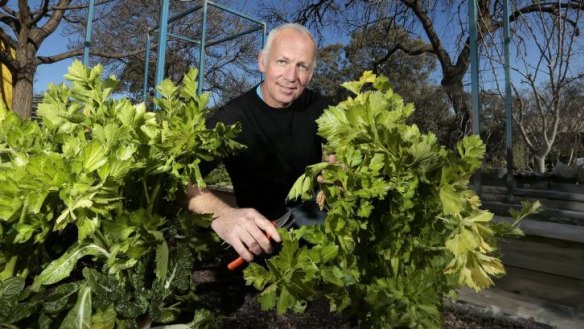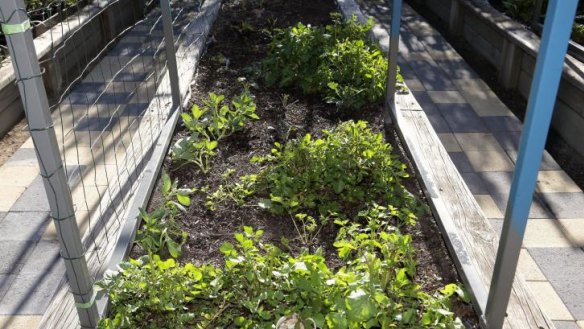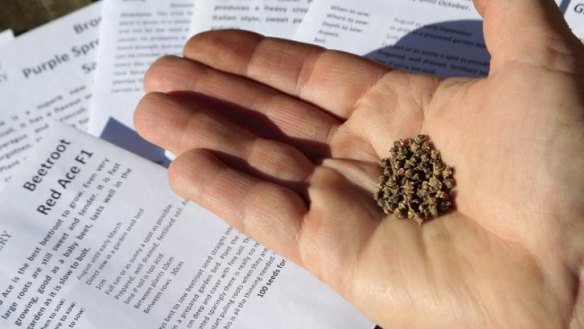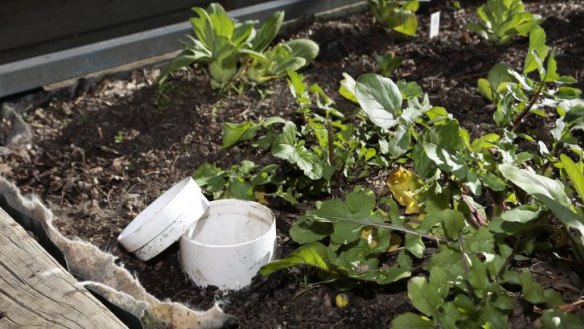City of food: How Canberra can feed itself

Dom Galloway and his wife Kate Hobbs grew up in Canberra but lived in other states because of work. They returned here in 1996 and moved into a house in Watson. He is a landscape architect with experience in the ACT and Federal governments and now runs a design practice specialising in residential projects.
Galloway says one of the occupational hazards of this background is that his own garden is a constant ground for experimentation. A couple of years ago the couple started converting raised vegetable beds to a wicking bed arrangement. Hobbs did most of the digging to temporarily remove garden soil. The soil now sits above a water reservoir and moisture is "wicked" up as it is needed by the plants. Galloway used pond liner to waterproof the bed and a membrane of Geotextile fabric to separate the soil and water. The reservoir is filled with large stones (or gravel can be used) to provide structural strength. It has been a great success and has far exceeded his expectations over conventional approaches.
During his studies pre-2009, Galloway discovered that Canberra produced hardly any of its own food. Since then the urban agriculture idea has been growing substantially and the catalyst for him to get something happening here was seeing artist and designer Ron Finley on TED talks. Technology, Entertainment and Design began in 1984 and Finley is a guerillagardener, who plants vegetable gardens on abandoned lots, traffic medians and along kerbs in deprived areas of Los Angeles, where he lives.

Urban Agriculture Australia is presenting A City of Food speakers’ series of four sessions next month . Galloway is involved in the Residential and Small Scale Approaches session on September 17 that will look objectively at the potential for smaller producers to contribute to the food supply chain. The main presenters will be Richard Stirzaker of CSIRO and Maartje Sevenster, an agricultural lifecycle and sustainability specialist.
At home in Watson, vegetable growing is generally Kate Hobbs’ domain, taking after her dad . In recent years she has preferred to raise vegetables from seed so she can access different varieties of produce not easily obtainable as seedlings. For planting out this spring Hobbs has made seed starting pots from newspaper using a wooden mould to form the tubes. Into these she has sown seeds of beetroot, carrots, cabbage, capsicum and broccoli purchased in packets sent from Lambley Nursery in Victoria.
During winter the couple has been picking celery, silverbeet, bok choy and roquette and any kale the possums haven’t eaten. They are growing lettuce, onions, beans, rhubarb and herbs for spring harvesting. A line of young bay trees has been planted to form a hedge between the nature strip and their kitchen garden.

Galloway says their number-one gardening tip is to have produce areas close at hand. If your herbs and vegetables are easily accessible to the kitchen they will be used and if you walk past them at least once a day they will be maintained. There is one more raised vegetable bed that the couple will convert to a wicking bed as the vegetables love a consistent level of moisture and this is an easy and efficient way of providing it. To avoid pitfalls, it is essential to get good information and advice.
Ten years ago Galloway started keeping bees. He has three hives, one in his own garden, one in his neighbours’ place and one at his parents’ house in Ainslie. His neighbours regularly comment on how much better their fruit trees have produced since the beehives have been in the adjoining backyards.
Hobbs and Galloway share the cooking. Apart from their homegrown produce, they buy from regional producers and boutique suppliers. A favourite dish in the household is the first meal Dom ever made for Kate. He says it must have been all right as they have been married for 23 years.

A City of Food sessions run from 6pm to 7.30pm at Pilgrim House in Northbourne Avenue, Canberra. Tickets $30 per event session, $25 for members of UAA. Bookings essential at www.uaa.org.au/city-of-food-series
Susan Parsons is a Canberra writer.
Lamb and celery stew
1kg lamb stewing chops
1.5 tbsp olive oil
2 large onions, chopped
1 tsp salt
1 tsp cinnamon
half tsp black pepper
1.75 cups chicken stock
2 cups celery, sliced
2 tbsp parsley, chopped
Remove gristle and excess fat from the chops. Fry the onions in oil until softened and lightly tinted, add chops, brown on both sides. Stir in salt, cinnamon, pepper and stock. Cover pan the simmer for 1.5 to 2 hours or until meat is tender. Fry the celery in a little butter, stirring constantly for five minutes. Stir in the parsley and simmer for two minutes. Mix into the meat and simmer, covered, for about seven minutes. Serve with rice or mashed potato. Serves 4.
Restaurant reviews, news and the hottest openings served to your inbox.
Sign up